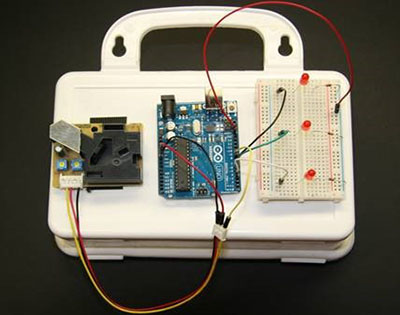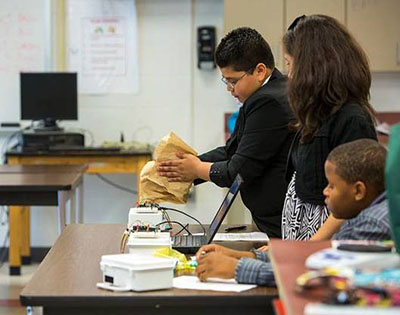The Air Quality Index and Sensors
Teachers, students, and citizen scientists from around the world are charging ahead to learn more about air quality from low-cost, portable air sensors. People are interested in:
- Comparing the Air Quality Index (AQI) posted on AirNow.gov and information from sensors
- Understanding the accuracy of sensor data at the neighborhood level and
- Engaging students in environmental science activities using air quality sensors.
AQI and Sensors
Both sensors and AirNow give you information about air quality. EPA recommends that you use AirNow for information on air quality and health. Here’s why:
AirNow reports the current AQI for ozone and particle pollution, two common air pollutants. The AQI is based on EPA’s National Ambient Air Quality Standards and the underlying scientific information about exposure to those pollutants and health. In addition, the monitors that report to AirNow are built and operated according to rigorous air monitoring regulations, and they provide high-quality data. Most low-cost sensors currently do not meet these same data quality standards.
What your sensor can do is give you helpful information about short-term (such as 1-minute) air quality levels right at your location that you can use to adjust your outdoor activities. For example, do you regularly see elevated particle pollution readings on your walk to work? Move a street over and see if they improve. If they do, you may want to change your route. Are you seeing elevated ozone readings that are lasting for a while in the afternoon? You might want to switch your afternoon run to the morning, when ozone levels typically are lower, or run on a treadmill at the gym.
Using Sensors: Exploring Local Air Quality
The air sensor technology market is expanding as more companies make lower-cost portable monitors available to the public. People are using air quality sensors to get more information about local air quality.
A growing number of air sensors for monitoring air quality are being made commercially available, encouraging more widespread use by individuals, citizen groups, researchers, regulatory officials, and in networks implemented by the private sector. Even though these devices are not as accurate or precise as the national ambient air monitoring network, some can provide useful information about very local air quality.
A wide variety of air sensor technologies currently exist in the market that offer streaming and real-time data capabilities. They vary in size, design, purpose (indoor or outdoor use), type of pollutants measured, power, and communications capabilities. Many cities in the United States currently have air sensor networks operating, with data collected privately or for sharing with the public. In addition, many citizens are procuring sensors for their private use to better understand their exposure to air pollution.
The reliability of these technologies, particularly over long periods of time, is currently not well known. As the technology is in a state of rapid innovation, new versions of air sensors are coming onto the market frequently. To understand whether these technologies produce reliable air pollution data, it is important to compare their performance against well-proven measurement methods. EPA is one of the recognized leaders in evaluating and testing these technologies, sharing information about their performance, as well as applying them in field studies with citizen scientists, states, tribes, communities and industry.
EPA scientists created a toolbox for air sensors to provide interested members of the public, also known as citizen scientists, with resources to effectively collect, analyze, interpret, and communicate air quality data. EPA’s Air Sensor Toolbox for Citizen Scientists provides information and guidance on new low-cost compact technologies for measuring air quality.
Engaging Students: Guide for Building a Particle Pollution Sensor
EPA also participates in educational outreach to schools, museums, and other locations to teach students about air quality to understand and protect the air we breathe. EPA developed a guide for building a particle pollution air sensor to teach older children (grades 5-12) about air quality and air science. The guide provides all the information needed to build an air quality sensor, and opportunities for students to do hands on wiring and coding.
The guide includes the following information:
- Instructions for buying the parts and building your own particle sensor
- A 10-minute activity that includes information on air pollution and explanation of how the PM air sensor works
- Discussion questions to ask students after the lesson
- Classroom handout
- Build Your Own Particle Sensor

Assembled sensor kits with different components.

Students working with air quality sensors.